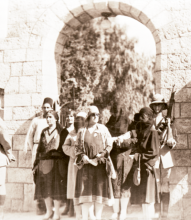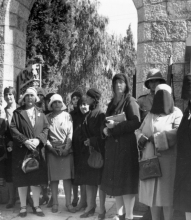Latifa Dirbas carries a jug of water on her head from the village of Bal'a, weaving from one mountain to the other while keeping track of the revolutionaries. Meanwhile, Umm Wedad Arouri leaves her village of Arura to Saffa, then to Birzeit , then to Ramallah , where she delivers an oral message to the rebels there. She answers their questions, describes the means of transport, and gives them supplies, telling them where the weapons are located. British soldiers stop Latifa on her way, but she tells them she's only going to fetch some coal.
Latifa and Umm Wedad were not alone in their actions. Women played a key role in supplying, informing, and financing the Palestinian Revolution. Women from villages sold their jewelry, while women in cities used their inheritance money to pay for the Revolt. 1
In the 1920s and 1930s, the entire Palestinian family was affected by colonial policies. But if only historical documents are observed, one will note the marked absence of women in this period, whether it be socially, economically, or in struggle. Even so, the Palestinian narrative before the Nakba will remain incomplete without examining and understanding the role of women in the struggle against colonialism.
Although colonial regimes have often claimed to champion women's liberation, supposedly aiming to spread “freedom and justice” to marginalized groups, even cursory scrutiny will reveal the spuriousness of such claims. Often, colonialism limited the parameters for women's emancipation, under the pretext of respecting local society, customs, and traditions.
But Palestinian women did not need colonialism to justify their actions. They fought in their homes and in the streets. They resisted colonialism politically, economically, and ethically. And quite crucially, they played an instrumental role in guerilla warfare by supporting the male fighters—as carriers of information, keepers of secrets, and smugglers of weapons. Their role in uplifting morale only bolstered such tasks.
From mountain to mountain I will carry your weapons
After the First World War, the Palestinians suffered major economic setbacks. Palestine had served as a battleground, leading to the damage of infrastructure, the exacerbation of an already harsh famine resulting from a locust plague, and subsequently, a drop in population. The devaluation of the currency and the disruption of the economy all added to the worsening conditions.2
In those circumstances, the British Mandate imposed employment laws that granted jobs to the petty bourgeois class at the expense of other classes. Education was neglected, garnering only 5% of budget allocations. At the end of 1927, the number of schools for boys was fifty-three, compared with only four schools for girls. This reflected the absence of women in colonial thinking, despite the slogans calling for their liberation. The colonial masters cynically blamed this absence on the attitudes of local society. This was the same justification the British used to grant women unspecialized jobs, claiming for instance that there were no qualified “Muslim female teachers” capable of working in rural areas.3 But the “efficiency” of rural women surpassed colonial expectations.
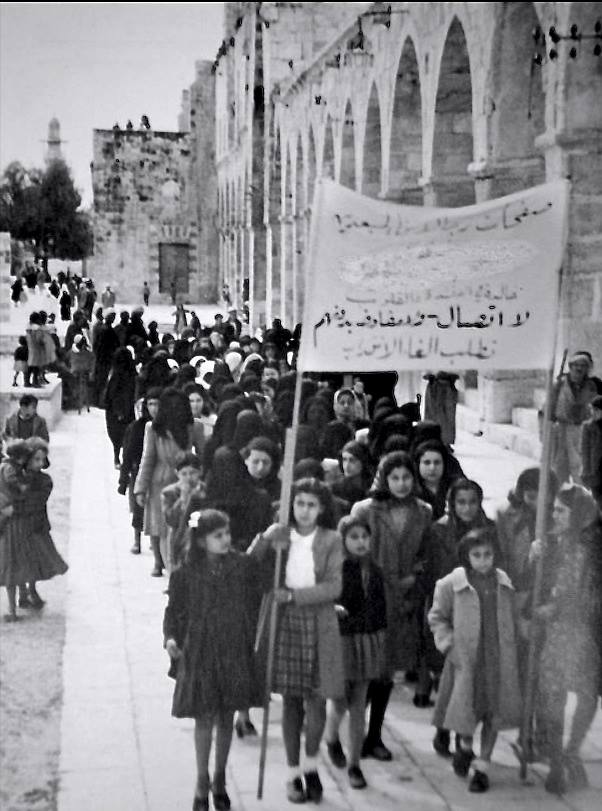
طالبات مدارس يتظاهرن ضد الانتداب البريطاني ويطالبن بالغاءه، القدس عام 1930
Rural women shared an intimate relationship with weapons. They would take care of weapons as if they were their own children—cleaning them, maintaining them, and hiding them in the fields. When the army attacked her village, Umm Ahmad hid the gun inside her dress before burying it in a potato field. After collecting some potatoes to cover up her act, one of the English soldiers mocked her and asked: “What are you doing?” Umm Ahmad replied: “I am taking these” - she held up the potatoes- “to feed him”- and pointed at her child. “Is that it?” the soldier asked. “That's it,” she insisted.4
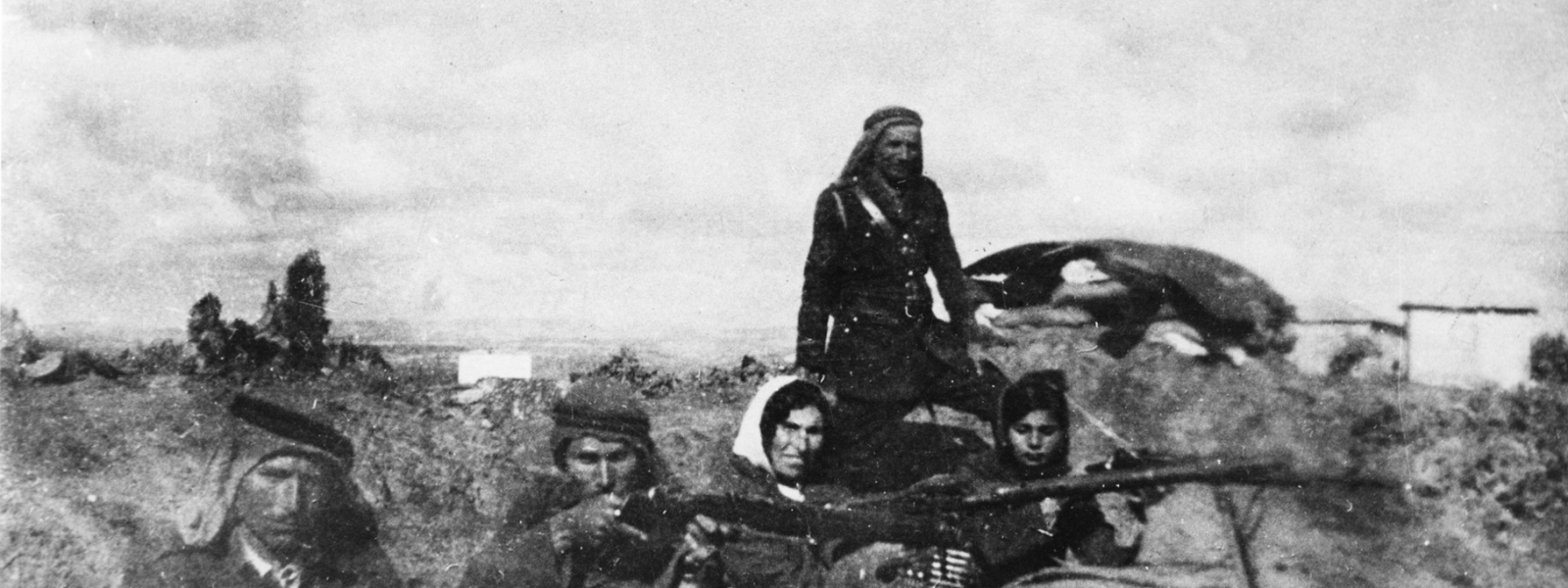
Women were trained in handling and firing weapons. Zakia Huleileh recounts how she was taught in operating the Sten and Tommy Guns, two English-manufactured machine guns. She found them hard to carry, but her brother would encourage and teach her: “he would place a rock as a target and tell me: shoot!”5
According to Hassna Masoud, the women of Tirat Haifa and Ramin were known for carrying weapons and fighting:
“When the guards of Abd al-Rahim al-Hajj Muhammad were captured, the women came out and fired at the English, to make them think that they had apprehended the wrong fighters.”6
This was verified by Sabha Yacoub from Ramin.7
The women played an important role in concealing weapons within their loose clothing, becoming a means of transport which fueled the logistics of the revolution. Fatima al-Khatib from Ain Bait al-Ma' recalled how she would hide weapons in her “bosom,” or in the fireplace, where she would “pile manure over it”.8
Women also played a coordinating role with the rebels to secure food supplies for besieged villages. When the British army besieged Baqa al-Gharbiyya, the soldiers rigged the bridges and roads leading to it with mines to cut supplies for villages and rebels. The women did not stand idly by when hunger threatened entire villages. They coordinated with the rebels, who raised white flags on the safe roads in order for women to reach the besieged villages safely.9
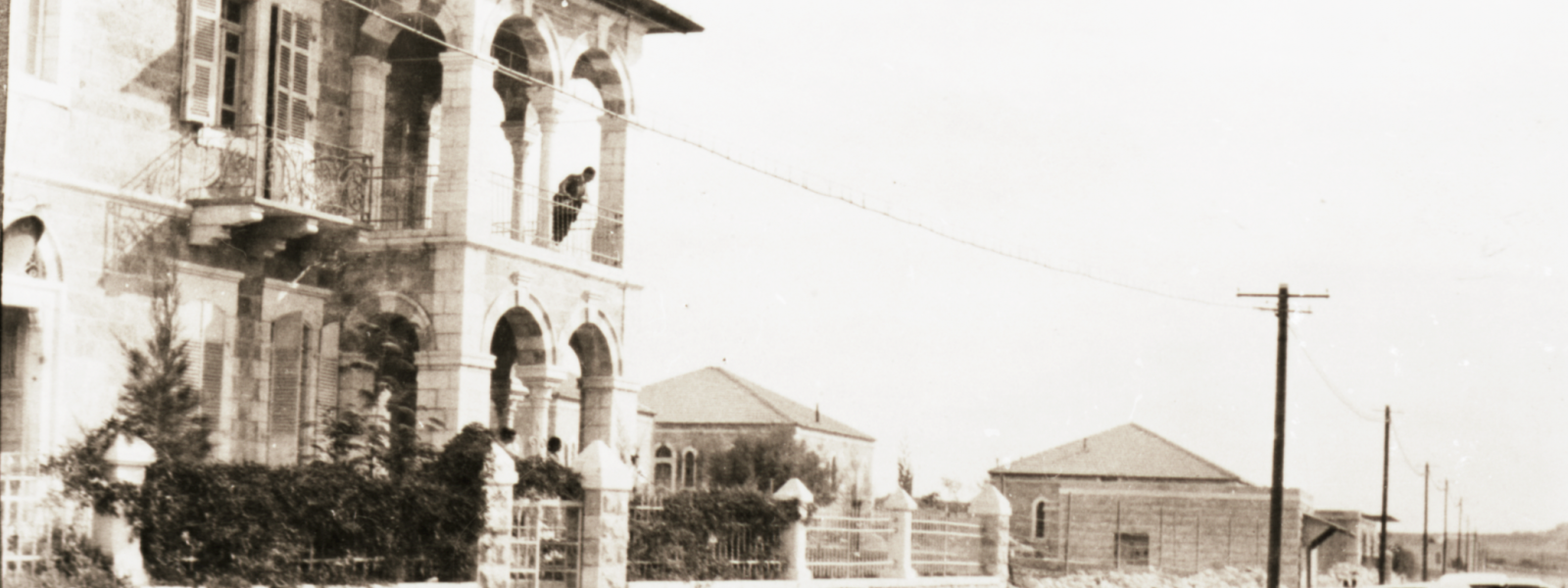
Women and the High Commissioner
Tarab Abdul-Hadi, one of the pioneers of the Palestinian national movement, lived in a small house East of Jerusalem during the British Mandate. From this house began the movement of a silent convoy of cars, which passed through the city of Jerusalem, and ended with a speech in front of the High Commissioner's headquarters. A list of demands from the demonstrators was presented to him.10 This took place immediately after the first women's conference was held in October 1929, with the participation of 300 Palestinian women.
This feminist movement did not emerge by happenstance. The clash with the British colonists led to the emergence of the Palestinian national movement, in which the question of identity was of primary importance. This also put the feminist movement in conflict with its national and social identity, and pushed it to search for its own political orientation and national discourse.
In the cities, women's associations were founded not only for charitable and women's issues, but for effective ways of resisting colonialism. Jerusalem was considered a civilian center, and acted as an incubator for these associations. Fayez Bey Haddad established the first Arab Women's Union in Jerusalem in 1919. The first Palestinian Women's Union was founded in 1921 under the leadership of Zuliekha Shehabi and Emilia Sakakini11, followed by the Women's Union in Nablus .12
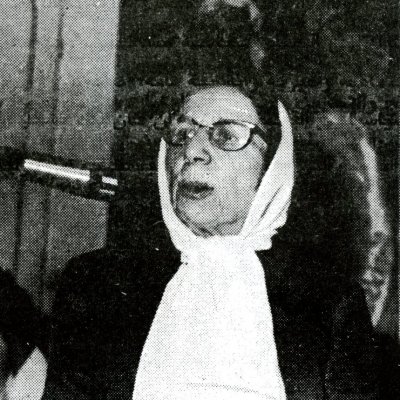
Zulaykha al-Shihabi was born in Jerusalem. Her father was Ishaq Abd al-Qadir al-Shihabi, and her mother was Zainab al-Muhtadi. She had two brothers, Subhi and Jamil, and two sisters, Rasmiyya and Rifqa.
She was educated at the Notre Dame de Sion school. Her father (unlike most fathers at the turn of the century) insisted on sending his daughters to school to learn the sciences and languages, and Zulaykha was among the top students in her class.
From an early age she became conscious of the dangers of Zionism. She had been raised in a family with deep roots in Jerusalem, and she learned the history of her city since its earliest Arab Islamic days. She in turn conveyed to her classmates what she had heard from her parents.
She joined the nationalist struggle during the turmoil that followed the al-Buraq rebellion. She was present at the Palestine Arab Women's Congress, which was held in Jerusalem in October 1929, was the first women's political meeting at the national level, and was attended by some two hundred women, to discuss the political situation. The meeting then issued a memorandum setting out the reasons behind the rebellion and the demands of the people. She was elected as a member of the delegation that presented the memorandum to the High Commissioner. Matiel Mughannam gave a short speech in English; Tarab Abd al-Hadi gave a speech in Arabic. When the delegation returned to the meeting, a massive demonstration by women broke out, with some one hundred cars driving through the streets of Jerusalem and shouting thunderous slogans, amidst enormous popular enthusiasm.
She cofounded the Arab Women Association in Jerusalem as a follow-up to the resolutions of the 1929 meeting. Similar women associations were
In the countryside, rural women played their own political role. When the British Mandate applied detention systems which left detainees naked without any regard for heat and extreme cold, rural women went to visit European consuls in Jerusalem, and managed to convince some of them to send a European doctor to examine the prisoners. This managed to save some of the prisoners from death.13
Other institutions were formed between the mid-1920s and the mid-1930s, including Ri'ayat al-Tifl al-Yafawiyya in Jaffa and al-Nahda al-Nisa'iyya in Ramallah in 1925. These were followed by the Women's Union in Jerusalem and the Women's Union in Acre in 1929, as well as the al-Ahsan Association in Haifa in 1930 and the Nahdat al-Fata al-Haifawiyya Association in Haifa in 1933.14 In 1928, the Arab Women's Association was established, and was the first society to explicitly state in its constitution the involvement of women in political work.15
There are two stories surrounding the meeting of these women activists with the wife of the High Commissioner to submit to her a list of demands. This was rejected on the grounds that the matter was a political one, and that the wife of the High Commissioner has nothing to do with politics.
According to the prevalent story, the High Commissioner expressed his pleasure at meeting the women and welcomed women's participation in politics. He stressed that he would make efforts to achieve peace and prosperity, but at the same time declared that he is not competent in dealing with some of the shortcomings of peace and prosperity. Rather, he pointed that the Ministry of Colonies is more proficient on this subject matter. History books typically relay what the English writer Miss Andrews wrote at the time:
“This organized demonstration, which followed the Arab women's program in working to make the Arab cause a success, revealed a significant power in the history of the Palestinian cause.”16
The High Commissioner appears in this story as a progressive British politician, and despite his “limited powers,” he appreciates the renaissance of these Arab women, which, it seems, was due to the open-mindedness of the civilized Mandate. But if we look at one of the High Commissioner's own papers, we discover an entirely different narrative.
The High Commissioner's official papers stated that he met with a delegation of Arab women during the conference, but rejected the delegation's request to organize a demonstration. He threatened some “Muslim leaders” that if they did not interfere to prevent the demonstration, their women might get beaten up by the authorities. These “Muslim leaders” cooperated and changed the arrangements for the demonstration, which took the side roads to reach the al-Aqsa Mosque. This explains the reason why such a march began in silence and not through main streets, a silence that, if not put in its real context, may give a false impression of the female protest action. Some of the women reported that they raised their headscarves over their hair when the High Commissioner was interviewed, as a sign of a lack of appreciation. Others refused to drink coffee, which was presented in the guest's hospitality, as a way to express their dissatisfaction.1718 Some men obeyed the threats of the High Commissioner and put pressure on women to change the course of the demonstration.
Healing the wound
Just as women took up arms and engaged in politics, they also played their role in war and in peace, healing wounds both physically and spiritually. Some Palestinian women received first aid courses, helping patients until the arrival of a doctor.
In the 1920s and 1930s, the executions of resistance fighters took place in Acre, and Tuesday became an official day of mourning. The women of Acre undertook the emotional labor of healing the psychological wounds of the families of detainees, martyrs, widows, and orphans, providing both emotional and financial support.19
طلت البارودة والسبع ما طل....
The manifestations of joy, songs, and ululations were always associated with the culture of the . Women were their champions, and the song, Ululate, Mother of the Martyr, imbued sacrifice for the sake of dignity, justice, and freedom with profound value. Women sang to raise an alarm when needed, and to incite enemies, as with the case of the singing of the women of Ya'bad 20:
Those are from Ya'bad and who could lay siege to them
Those who carry guns and daggers around their waists
I asked God above to award you victory
A sweet victory that is befitting of you
When Palestinian leader Fawzi al-Qawuqji mentioned the intensity of the fervor that surrounded his meeting with the leaders of the Palestinian factions in August 1936, he regarded gunpowder and women's songs as equally important.21 Popular memory has a sizable stock of folk songs associated with the Revolt, characterized by spontaneity, intimacy, and improvisation. Peasant poetry showcased women's capability in this field. Najia Barham from the village of Ramin, recalled when she was a small child the lament the martyr and leader Abd al-Rahim al-Hajj Muhammad22:
درّج هالفرس من نصّ قاع الدار بيظا محجّلة تلفي ع أبو كمال
درّج هالفرس من نصّ هالحارة بيظا محجّلة تلفي ع سارة
أبو كمال بحور كثير قطعها وكم بلاد بظرب السّيف حماها
أبو كمال قمر يظوي على الخلّة وخيوله قوطعت ليكم يا عصملّه
أبو كمال قمر يغطّي ع الغابة وخيوله قوطعت ليكم يا ركّابِ
ع قيادتنا لنطيح الحروبات نطلّعها سمعة ونشكل البنات
ع قيادتنا لنطيح ع الشّام نطلعها سمعة ونشكل النّسوان
عقيادتنا لنطيح ع جنين نطلعها سمعة ونشكّل الحريم
أبو الرّاجح بلاد الغرب إله فيه إن اختلفت القيادة عنده يلفيها
ريّس العصابة قال أبو الرّاجح من كلّ شدّة يا ريته ناجح
بدّه لربوعه سبع ذبايح مجاري الهنا للّي ذوّقونا
SELECTED BIBLIOGRAPHY
- 1Abdul Hadi, Fayha'. “Adwar al-mar'a al-filastiniyya fi al-thalathinat 1930 – al-musahama al-siyasiyya lil mar'a al-Filastiniyya [The role of the Palestinian Woman in the Thirties, the Political Participation of the Palestinian Woman]. Al- Bira: Markaz al-Mar'a al-Filastiniyya lil-Abhath wa al-Tawthiq, 2005, p. 46.
- 2Fleischmann, Ellen. Jerusalem Women's Organizations During the British Mandate, 1920s-1930s. Jerusalem: Passia, 1994, p. 13.
- 3Ibid, pp. 12-15.
- 4Abdul Hadi, Palestinian Women, p. 84.
- 5Ibid, p. 88.
- 6Kabaha, Mustafa, and Nimer, Sarhan. Sijil al-Qada wa al-Thuwar wa al-Mutatau'een Lithawrat 1936-1939 [A Record of Leaders, Revolutionaries, and volunteers in the Revolution of 1936-1939]. Kufr Qare': Dar al-Huda, 2009, p. 298.
- 7Ibid, p. 925.
- 8Abdul Hadi, Palestinian Women, pp. 83-85.
- 9Khartabil, Wadi'a. “Dhikrayat wa Muthakarrat Qadura Khartabil, Bahthan ‘an al-amal wa al-Watan, Situn ‘Aman min Kifah Imra'a fi Sabil Qadiyyat Filastin [Memories and Memoirs of Qadura Khartabil, In Search of Hope and a Homeland, Sixty years of a woman's struggle for Palestine].” Beirut: Bisan Publishing House, 1995, p. 76.
- 10Alqam, Nabil. Tarikh al-Haraka al-Wataniyya al-Filastiniyya wa Dawr al-Mar'a Fiha [History of the Palestinian National Movement and the role of women in it]. Al-Bira: Markaz Dirasat al-Turath wa al-Mujtama', 2005, p. 86.
- 11Abdul Hadi, Palestinian Women, p. 202.
- 12Alqam, Palestinian National Movement, p. 81.
- 13Abdul Hadi, Palestinian Women, pp. 68-69.
- 14Alqam, Palestinian National Movement, p. 81.
- 15Khartabil, Memories and Memoirs, p. 57.
- 16Alqam, Role of Palestinian Women, pp. 174-175.
- 17Fleischmann. Jerusalem Women, pp. 25-26.
- 18Abdul Hadi, Palestinian Women, p. 37.
- 19Saleh, Jihad. Asma' Tobi 1905-1983, Ra'idat al-Kitaba al-Nasawiyya fi Filastin [Asma' Tobi 1905-1983, pioneer of feminist writing in Palestine]. Al-Bireh: Palestinian Authority Ministry of Culture, 2011, p. 30.
- 20Aqel, Mohammed. Dawr al-Mar'a al-Filastiniyya fi Tharwat 'Am 1936 [The Role of Palestinian Women in the 1936 Revolution.] 2013. Web. 20/05/2015. http://www.qudsn.co/article/31493
- 21Kabaha, Record of Leaders, p. 693.
- 22Ibid, p. 518.
